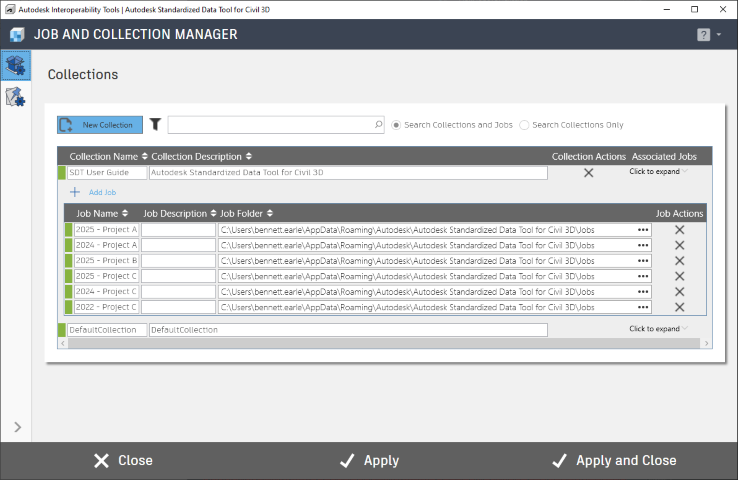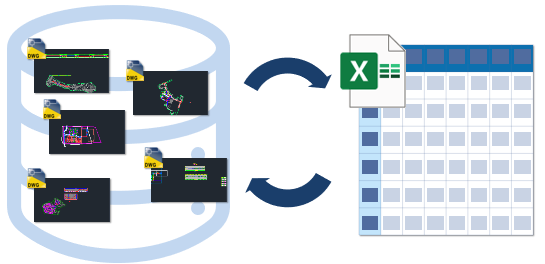Workflow
Any engineer or project team can take of advantage of SDT. Existing project model files can be added to a Job and analyzed through the SDT workflow. Review the following workflow to get SDT up and running on your project.
Overall
From a blank Civil 3D drawing start the Collection Manager.

Create a new Collection.

Create a new Job.

Select the JMF directory and select the existing Civil 3D project files.
Open a project drawing and use the Update Standards command to link the Project Model Files with the Job Standards File and its Property Set Information.

Attach Data to all relevant model features with the Attach Extended Data command.

Use the Sync Data command to send the civil information to Microsoft Excel.

Review the data in Microsoft Excel. Edit any properties, if supported. Save and close the worksheet.
Close the Project Drawing and return to a blank drawing.
Use the Sync Data command to sync the data from Microsoft Excel to Civil 3D.
Job and Collection Setup
The Collection Manager and Job Manager workflows are designed to help teams manage multiple job model files. During the project setup phase, this important step will help organize project data into a pool. Going forward any engineer or designer will be able to utilize the existing system of Job-related files and jump into the project.

To set up a Job:
Close all drawings not associated with the project.
a. It is not possible to add Job Model Files to a Job while that drawing is open.From the Standardized Data Tool tab of the Civil 3D ribbon, select the Collection Manager button.

On the left-side of the dialog, note the two icons. The upper icon is the Collection Manager. The bottom icon is the Job Manager.

From the Collection Manager dialog, create a new Collection or expand an existing Collection from the dialog. Use the Apply button to apply the changes.
Once the Collection is selected, select an existing Job or choose Add Job to create a new job. Click Apply to apply the new Job to the manager.

Select the Job Manager icon from the left sidebar. If JMF’s exist for the Job, they will be displayed on the Job Manager dialog. To add new JMF’s to the Job, select the Add Model link.
From the dialog select the file browser
 from the Folders tab, and navigate to the folder that contains the Civil 3D or AutoCAD project drawings (JMF), then click the Select Folder button.
from the Folders tab, and navigate to the folder that contains the Civil 3D or AutoCAD project drawings (JMF), then click the Select Folder button.Review the DWG files displayed in the dialog. Use the plus
 symbol to add Model Files to the Job.
symbol to add Model Files to the Job.
a. Note multiple files may be selected by holding the SHIFT and/or CTRL keys and selecting multiple files.Finish and Close the JMF dialog window, then Apply and Close the Job and Collection Manager.
a. Once a file is added, the DWGPROPS will be modified to associate that file with that specific Job and Collection. JMF’s cannot belong to multiple jobs.
Updating Standards and Attaching Data to Model Objects
Once the Project Model Files have been associated with a Job, it is important to ensure that those Job Model Files (DWG) agree with the Job Standards File. Using the Update Standards Command prior to running the Attach Data command ensures that the JMFs have matching Property Set Definitions to the Job Standards. The Attach Data command than can be confidently run to add property set data to your model objects. Note that many SDT commands have batch command equivalents to perform actions on multiple Job files.
From the SDT Job Explorer palette or the Civil 3D open dialog, open a Job Model File.
From the Standardized Data Tool ribbon, select Update Standards. This command will sync the current JMF with the existing Job Standards File associated with the Job and Collection.

From the ribbon, select Attach Extended Data command. From the dialog box select the objects to attach SDT Property Set Data to and enable synchronization with Excel.

Select Apply and Close. This function may take several moments depending on the number of objects and properties attached during the command.
The Update Standards command should be used anytime the Job Standards File is revised or if Property Set Definitions are revised within the individual JMF.
Round-Trip Data with Excel
To make working with the data within the civil information model easily accessible, Microsoft Excel was an ideal tool for data review, editing, or reporting. This allows team members, such as project managers that may not have access to Civil 3D, to interact with the civil information model data. With Excel, the project data can be visualized and formatted through the JDF and extended through the use of other software such as Power BI.

From an open Job Model File select the Standardized Data Tool tab from the ribbon.
Select the Sync Data command.

A dialog will warn that the Sync Data command may take a long time. Acknowledge this message.
From the Sync Data dialog, select the desired Sync Direction. Model File (Civil 3D) > Data File (Excel) is typically the first direction.

Choose what data should be synchronized – overwrite data or populate blank properties.
Select Next.
At the Choose Your Properties dialog, use the check boxes to select all the properties within each Property Set Definition you would like to sync.

Select the Sync button. The command will now run and, once completed, you may use the Open Job Data File command to review the information.

If the Job Data File includes properties that allow for user input, these cells can be populated in Excel and that JDF can be saved and closed.
Close the project drawing file and return to a blank drawing file.
To round-trip the project data, return to Civil 3D and run the Sync Data command.
Change the sync direction to Data File (Excel) > Model File (Civil 3D) and choose Next.

Select the properties to sync and select the Sync button.

The features and entities within the Job Model File drawing will now be updated with the data from the JDF.
